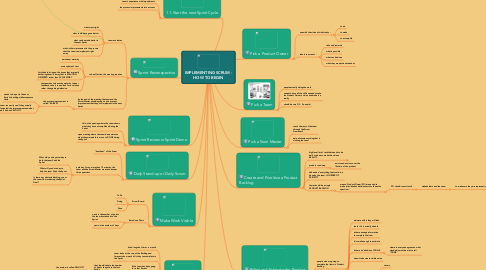
1. "The key thing to remember is that you're not seeking someone to blame, you're looking at the process?"
2. Sprint Planning
2.1. fixed length of time < a month
2.2. team looks at the top of the Backlog and forecasts how much of it they can complete in the Sprint
2.3. if the team has been going for a few Sprints
2.3.1. they should take in the number of points they did in the last Sprint
2.3.1.1. the number is called VELOCITY
2.4. the team and the Scrum Master should increase VELOCITY every Sprint
2.5. chance for the team and Product Owner to make sure everyone understands that these items are going to fulfill the vision
2.6. everyone should agree on a Sprint Goal, what everyone wants to accomplish with this Sprint
3. Sprint Review or Sprint Demo
3.1. this is the meeting where the team shows what they have accomplished during the Sprint
3.2. open meeting where the team demonstrates what they were able to move to DONE during the Sprint
4. Daily Stand-up or Daily Scrum
4.1. "heatbeat" of the Scrum
4.2. each day for no more than 15 minutes, the team and the Scrum Master meet and answer three questions
4.2.1. What did you do yesterday to help the team finish the Sprint
4.2.2. What will you do today to help the team finish the Sprint
4.2.3. Is there any obstacle blocking you or the team from achieving the Sprint Goal?
5. Make Work Visible
5.1. Scrum Board
5.1.1. To Do
5.1.2. Doing
5.1.3. Done
5.2. Burn-down Chart
5.2.1. x-axis is the number of points the team has taken into the Sprint
5.2.2. y-axis is the number of days
6. Sprint Restrospective
6.1. team evaluates
6.1.1. what went right
6.1.2. what could have gone better
6.1.3. what can be made better in the next Sprint
6.1.4. what is the improvement in the process that the team can implement right away
6.2. to be effective, the meeting requires
6.2.1. emotional maturity
6.2.2. atmosphere of trust
6.2.3. fortitude to bring up the issues that are really bothering them in a way that is SOLUTION ORIENTED rather than ACCUSATORY
6.2.4. the team has to have the maturity to hear feedback, take it in and look for a solution rather than getting defensive
6.3. by the end of the meeting the team and the Scrum Master should agree on one process improvement that they will implement in the next Sprint
6.3.1. the process improvement is called "KAIZEN"
6.3.1.1. needs to be put in the next Sprint's backlog with acceptance tests
6.3.1.2. the team can easily see if they actually implemented the improvement and what effect it had on VELOCITY
7. 11. Start the next Sprint Cycle
7.1. team's experience with impediments
7.2. the process improvements into account
8. Pick a Product Owner
8.1. one with the vision of what tasks :
8.1.1. to do
8.1.2. to make
8.1.3. to accomplish
8.2. take into account :
8.2.1. risks and rewards
8.2.2. what is possible
8.2.3. what can be done
8.2.4. what they are passionate about
9. Pick a Team
9.1. people actually doing the work
9.2. needs to have all the skills needed to take the Product Owner's vision and make it a reality
9.3. should be small (3 - 9 people)
10. Pick a Srum Master
10.1. coach the rest of the team through the Scrum Framework
10.2. help eliminate anything that is slowing the team
11. Create and Prioritize a Product Backlog
11.1. high level list of task that needs to be built or done to make the vision a REALITY
11.1.1. Type
11.1.2. Topic
11.2. product road map
11.2.1. exists and evolves over the lifetime of the product
11.3. defined as "everything that could be done by the team, IN ORDER OF PRIORITY
11.4. there should be a single PRODUCT BACKLOG
11.4.1. means: Product Owner (PO)is required to make prioritization decisions across the entire spectrum.
11.4.1.1. PO should consult with
11.4.1.1.1. stakeholders and the team
12. Refine and Estimate the Product Backlog
12.1. people who are going to complete the items in Product Backlog
12.1.1. estimate effort they will take
12.1.2. check if it is actually doable
12.1.3. is there enough information to complete the item
12.1.4. is it small enough to estimate
12.1.5. is there a definition of DONE
12.1.5.1. where in everyone agrees on what standards must be met to call "DONE"
12.1.6. does it take create visible value
12.1.7. each item must also be
12.1.7.1. shown
12.1.7.2. to be demonstrated
12.1.7.3. to be potentially shippable
12.1.8. estimate PO
12.1.8.1. by relative size
12.1.8.1.1. small
12.1.8.1.2. medium
12.1.8.1.3. large
12.1.8.2. Fibonacci sequence and estimate the point value for each item

